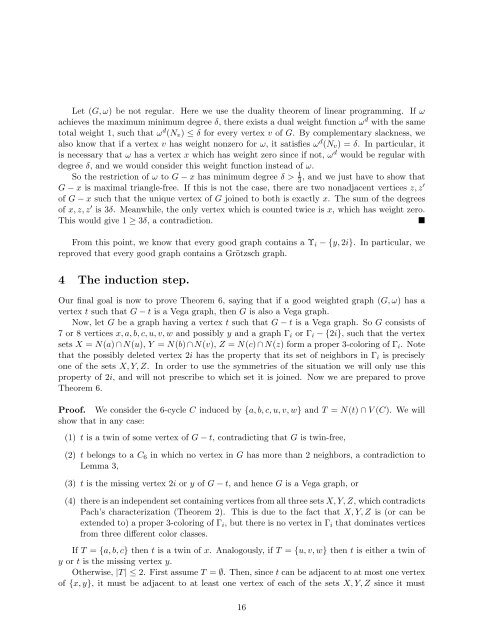Dense triangle-free graphs are four-colorable: A solution to ... - Lirmm
Dense triangle-free graphs are four-colorable: A solution to ... - Lirmm
Dense triangle-free graphs are four-colorable: A solution to ... - Lirmm
You also want an ePaper? Increase the reach of your titles
YUMPU automatically turns print PDFs into web optimized ePapers that Google loves.
Let (G, ω) be not regular. Here we use the duality theorem of linear programming. If ω<br />
achieves the maximum minimum degree δ, there exists a dual weight function ω d with the same<br />
<strong>to</strong>tal weight 1, such that ω d (Nv) ≤ δ for every vertex v of G. By complementary slackness, we<br />
also know that if a vertex v has weight nonzero for ω, it satisfies ω d (Nv) = δ. In particular, it<br />
is necessary that ω has a vertex x which has weight zero since if not, ω d would be regular with<br />
degree δ, and we would consider this weight function instead of ω.<br />
So the restriction of ω <strong>to</strong> G − x has minimum degree δ > 1<br />
3 , and we just have <strong>to</strong> show that<br />
G − x is maximal <strong>triangle</strong>-<strong>free</strong>. If this is not the case, there <strong>are</strong> two nonadjacent vertices z, z ′<br />
of G − x such that the unique vertex of G joined <strong>to</strong> both is exactly x. The sum of the degrees<br />
of x, z, z ′ is 3δ. Meanwhile, the only vertex which is counted twice is x, which has weight zero.<br />
This would give 1 ≥ 3δ, a contradiction. <br />
From this point, we know that every good graph contains a Υi − {y, 2i}. In particular, we<br />
reproved that every good graph contains a Grötzsch graph.<br />
4 The induction step.<br />
Our final goal is now <strong>to</strong> prove Theorem 6, saying that if a good weighted graph (G, ω) has a<br />
vertex t such that G − t is a Vega graph, then G is also a Vega graph.<br />
Now, let G be a graph having a vertex t such that G − t is a Vega graph. So G consists of<br />
7 or 8 vertices x, a, b, c, u, v, w and possibly y and a graph Γi or Γi − {2i}, such that the vertex<br />
sets X = N(a) ∩ N(u), Y = N(b) ∩ N(v), Z = N(c) ∩ N(z) form a proper 3-coloring of Γi. Note<br />
that the possibly deleted vertex 2i has the property that its set of neighbors in Γi is precisely<br />
one of the sets X, Y, Z. In order <strong>to</strong> use the symmetries of the situation we will only use this<br />
property of 2i, and will not prescribe <strong>to</strong> which set it is joined. Now we <strong>are</strong> prep<strong>are</strong>d <strong>to</strong> prove<br />
Theorem 6.<br />
Proof. We consider the 6-cycle C induced by {a, b, c, u, v, w} and T = N(t) ∩ V (C). We will<br />
show that in any case:<br />
(1) t is a twin of some vertex of G − t, contradicting that G is twin-<strong>free</strong>,<br />
(2) t belongs <strong>to</strong> a C6 in which no vertex in G has more than 2 neighbors, a contradiction <strong>to</strong><br />
Lemma 3,<br />
(3) t is the missing vertex 2i or y of G − t, and hence G is a Vega graph, or<br />
(4) there is an independent set containing vertices from all three sets X, Y, Z, which contradicts<br />
Pach’s characterization (Theorem 2). This is due <strong>to</strong> the fact that X, Y, Z is (or can be<br />
extended <strong>to</strong>) a proper 3-coloring of Γi, but there is no vertex in Γi that dominates vertices<br />
from three different color classes.<br />
If T = {a, b, c} then t is a twin of x. Analogously, if T = {u, v, w} then t is either a twin of<br />
y or t is the missing vertex y.<br />
Otherwise, |T | ≤ 2. First assume T = ∅. Then, since t can be adjacent <strong>to</strong> at most one vertex<br />
of {x, y}, it must be adjacent <strong>to</strong> at least one vertex of each of the sets X, Y, Z since it must<br />
16

















